
Huntsman spiders, members of the family Sparassidae, are known by this name because of their speed and mode of hunting. They are also called giant crab spiders because of their size and appearance. Larger species sometimes are referred to as wood spiders, because of their preference for woody places. In southern Africa the genus Palystes are known as rain spiders or lizard-eating spiders. Commonly they are confused with baboon spiders from the Mygalomorphae infraorder, which are not closely related.

Nursery web spiders (Pisauridae) is a family of araneomorph spiders first described by Eugène Simon in 1890. They resemble wolf spiders (Lycosidae) except for several key differences. Wolf spiders have two very prominent eyes in addition to the other six, while a nursery web spider's eyes are all about the same size. Additionally, female nursery web spiders carry their egg sacs with their jaws and pedipalps instead of attaching them to their spinnerets as wolf spiders do. When the eggs are about to hatch, a female spider builds a nursery "tent", places her egg sac inside, and stands guard outside, hence the family's common name. Like the wolf spiders, however, the nursery web spiders are roaming hunters that don't use webs for catching prey. They have a wide variety of prey, and larger species may prey upon vertebrates, particularly amphibians and fish.
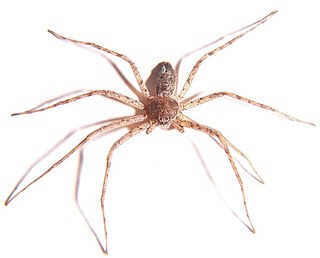
Philodromidae, also known as philodromid crab spiders and running crab spiders, is a family of araneomorph spiders first described by Tord Tamerlan Teodor Thorell in 1870. It contains over 600 species in thirty genera. Most are dull colored- brown, gray, yellowish or mottled with a leaf-like cardiac mark on the anterior dorsal abdomen, and seldom reach above 10 millimetres (0.39 in) long. None of the species build webs, but they do use silk for draglines and egg sacs.
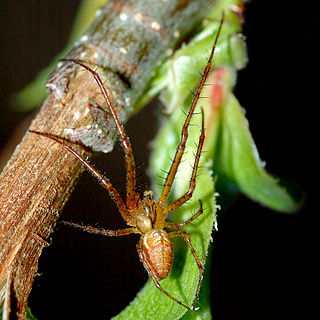
Long-jawed orb weavers or long jawed spiders (Tetragnathidae) is a family of araneomorph spiders first described by Anton Menge in 1866. They have elongated bodies, legs, and chelicerae, and build small orb webs with an open hub with few, wide-set radii and spirals with no signal line or retreat. Some species are often found in long vegetation near water.

Scaffold web spiders (Nesticidae) is a family of araneomorph spiders closely allied with tangle web spiders. Like the "Theridiidae", these spiders have a comb of serrated bristles on the hind tarsi that are used to pull silk bands from the spinnerets. It contains 16 genera and about 300 species, many of which are associated with caves or overhangs. The genus Nesticus is the type for the family and is found throughout the world. The related Eidmannella has speciated considerably in Texas caves and includes some extremely localized species that are considered threatened. One species, Eidmannella pallida, is found in caves and under overhangs, but also in agricultural fields and other habitats away from such restricted areas. The genus Carpathonesticus is found in central Eurasia.
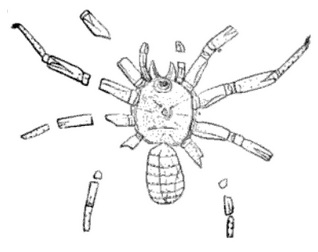
Arthrolycosidae is an extinct family of arachnids, possibly spiders. Fossils placed in the family were found in the Carboniferous to Permian, 359 to 252 million years ago. They were considered by Alexander Petrunkevitch to be "mesotheles", i.e. placed in the spider suborder Mesothelae. However, Paul A. Selden has stated they only have "the general appearance of spiders", with segmented abdomens (opisthosomae), but no definite spinnerets. At least some of the specimens placed in the family in the genus Arthrolycosa are considered to be spiders, whereas Eocteniza is "rather problematic as a spider".

Araneus is a genus of common orb-weaving spiders. It includes about 650 species, among which are the European garden spider and the barn spider. The genus was erected by Carl Alexander Clerck in 1757.
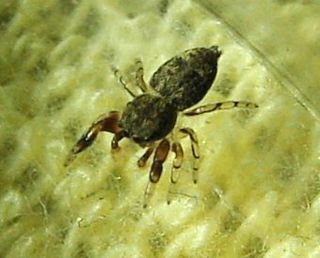
Ballus is a spider genus of the family Salticidae.

Zygoballus is a genus of jumping spiders found in North and South America.

Mysmenidae is a spider family with about 135 described species in thirteen genera. The family is one of the least well known of the orb-weaving spiders because of their small size and cryptic behaviour. These spiders are found in humid habitats such as among leaf litter and in caves.

Araneus cavaticus, commonly known as the barn spider, is a common orb-weaver spider native to North America. They are around three-quarters of an inch (20 mm) in length and are usually yellow and brown in color. They often construct their webs in wooden human structures, hence their common name. The species is notable for being the basis for the character Charlotte in the book Charlotte's Web by American writer E. B. White.
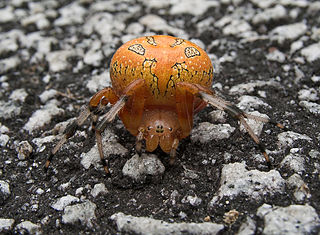
Araneus marmoreus, commonly called the marbled orb-weaver, is a species of spider belonging to the family Araneidae. It is sometimes also called the pumpkin spider from the resemblance of the female's inflated abdomen to an orange pumpkin. It has a Holarctic distribution.
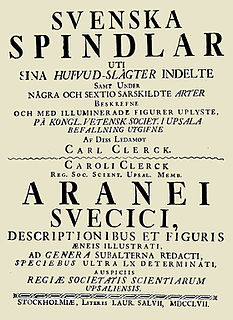
The book Svenska Spindlar or Aranei Svecici was one of the major works of the Swedish arachnologist and entomologist Carl Alexander Clerck and appeared in Stockholm in the year 1757. It was the first comprehensive book on the spiders of Sweden and one of the first regional monographs of a group of animals worldwide. The full title of the work was Svenska Spindlar uti sina hufvud-slägter indelte samt under några och sextio särskildte arter beskrefne och med illuminerade figurer uplyste – Aranei Svecici, descriptionibus et figuris æneis illustrati, ad genera subalterna redacti, speciebus ultra LX determinati, and included 162 pages of text and 6 colour plates. It was published in Swedish, with a Latin translation printed in a slightly smaller font below the Swedish text.
Metaphidippus pernix is a species of spider in the Salticidae family found in Guatemala.
Phrurolithidae is a family of araneomorph spiders first described by N. Banks in 1982. First included in the Corinnidae as the subfamily Phrurolithinae, later phylogenetic studies justified a separate family.

Misumessus is a genus of North American and Caribbean crab spiders first described by Nathan Banks in 1904. They look similar to members of Misumena, but are much spinier. It was considered a monotypic genus until 2017, but its taxonomic standing has been debated throughout the 20th century, first as a synonym of Misumenops, then later as its subgenus. It was raised to genus status in 2008, but has still been confused with similar genera, some of which were only known by character descriptions made by Eugène Simon nearly fifty years earlier.

Wulfila is a genus of ghost spiders first described by O. Pickard-Cambridge in 1895. They are easily recognized by their pale white elongated legs.
Physoglenidae is a family of araneomorph spiders first described by Alexander Petrunkevitch in 1928 as a subfamily of Pholcidae. It was later moved to Synotaxidae until a study in 2016 showed that they formed a distinct clade.
Scotinella is a genus of North American araneomorph spiders in the family Phrurolithidae, first described by Nathan Banks in 1911.














